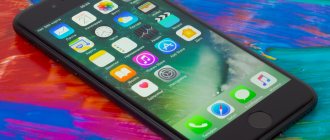© Andrey Bezukladnikov / Photographer.ru
What a joy it is to notice a picturesque composition of anything along the way, be it a beautifully lit fragment of a building or a bizarre tangle of trees, to take a camera out of your pocket, capture the beauty, just for fun, and continue on your way.
The start of global sales of the iPhone X on November 3, 2017 caused serious excitement. In big cities, fans who wanted to be the first to receive a new smartphone lined up the day before. The first batch of devices that arrived in Moscow stores was sold out within an hour. The “X” in the name symbolizes the decade since the premiere of the first iPhone, unveiled by Steve Jobs at Macworld in 2007 and forever changing the understanding of what a mobile phone should be. Over the course of ten years, there have been 14 generations of iPhone, each of which has become a scientific and technical standard for the high-tech industry. According to Apple, the iPhone X marks the beginning of a new era in the evolution of smartphones. Colleagues at Apple invited me to try out the iPhone X, which they lovingly call “the smartphone of the future.”
Apple's success in the creative environment is dictated by the company's perfectionistic attitude to the design and quality of its products, be it a computer, smartphone or accessory. The primacy of design and the pursuit of maximum quality, the synthesis of art and science, is the basis of the corporate culture of Apple and iPhone X again confirms this.
And, yes, this is not an advertisement, if anything.
Special feature - very handsome
© Andrey Bezukladnikov / Photographer.ru
The finest details are skillfully combined into an aesthetically perfect artifact made of heavy-duty glass and stainless steel. The cosmic blackness of the full-screen display, which fills the front surface of the device from edge to edge, comes to life with all the colors of the rainbow from a light touch. The morning mist-colored glass back features a mirrored Apple logo. The weight feels pleasantly heavy on the hand. Convenient size, 15mm shorter and 7mm narrower than the 8 Plus, but with a comparable display area.
Three core values underpin the innovative uniqueness of iPhone X - a full-screen OLED display, facial recognition technology and a dual 12-megapixel camera. Let's take a closer look at them.
I’ll probably start with the camera, because we’re on a photography site.
Computer photography wins the match
It's interesting to see how such similar 12MP lenses produce such different results. It's not magic, although it seems like it, but it ties in, among other things, with Deep Fusion as the main differentiating element. The term refers to the phone's photo processing, computational enhancement, and learning system that greatly improves photography results. This is the mechanism implemented in the iPhone 11, and it can be foreseen that it will be supported in every generation and will be improved at every stage, but comparing an iPhone like X without this system and an iPhone like X without this system and the same , like 12, which includes her, is the least ruthless for the first. For all intents and purposes, photos taken on the iPhone 12 will be better than those taken on the iPhone X , although each person's perception and taste also comes into play here, which is extremely subjective.
A camera that you always have with you
The iPhone X wouldn't be nearly as attractive without the 12-megapixel dual-camera setup that turns it into a full-fledged camera and video camera. A similar camera is installed in the iPhone 8 Plus, but there is one important difference - the iPhone X telephoto lens is 16.7% faster - f/2.4 versus f/2.8 and is equipped with optical stabilization, which was so lacking in the 8 Plus. The lenses are protected by sapphire crystal, which is only harder than diamond.
Main characteristics of the camera:
- 12-megapixel main camera with f/1.8 wide-angle lens with optical stabilization
- 12-megapixel telephoto camera with f/2.4 lens with optical stabilization
- Autofocus with Focus Pixels technology
- True Tone Quad-LED Flash with Slow Sync
- Portrait mode with portrait lighting
- 4K video – 60 frames per second
- 7-megapixel f/2.2 selfie camera with portrait mode
Smart camera algorithms accurately determine exposure and white balance. You can shoot in any conditions and with any lighting. The photo matrices are the same as in the iPhone 8 Plus, however, increasing the aperture and optical stabilization of the telephoto lens gives noticeably better results when shooting in low light conditions. In my subjective impression, the noise reduction mechanism has also evolved - “night” photographs taken at the maximum sensitivity have become sharper and more flexible.
Cars
Now let's turn to the Soviet automobile industry. Who else here likes the Volga, which is the GAZ-24?
iPhone X
iPhone XR
In the photo we again see the meager dynamic range of the iPhone XR compared to the “tens” camera. But overall both photos are of acceptable quality. Now let's turn to the details.
iPhone X
iPhone XR
The large matrix again makes itself felt - with cropping, pictures taken on XR look sharper. Thanks for this and more contrast in the pictures. In this photo it is easier to see the details of the headlight and the streaks on the chrome bumper.
iPhone X
iPhone XR
And in this photo everything is much more obvious. The photo taken with the iPhone XR does not have the same highlights as the photo taken with the iPhone XR. Smart HDR does an excellent job in this regard. But the photo taken on the XR looks warmer - the difference in shades of red is very easy to notice. That is, XR gets a minus for the objectivity of color rendering.
iPhone X
iPhone XR
When you get closer, the difference between the two generations of cameras looks much more obvious: I don’t even understand why the iPhone X took such bad pictures. And it's not a matter of lack of focus, no. It is on the red car exactly as we installed it. But for selling a car on Avito it will do.
Day, good weather
iPhone X, HDR, ISO 20, 4 mm, ƒ/1.8, 1/630 sec. © Andrey Bezukladnikov / Photographer.ru
It’s a fine autumn morning outside and you decide to take a walk around the city, admire the reflections in the mirror of the river, the transparent shadows of trees adorning the walls of well-worn buildings, look for colorful characters in the motley crowd of idle tourists, and go for a visit. If you are a photographer, then you probably take with you a bag with a camera, and even a couple of lenses, just in case. This was my scenario before the advent of “dual-lens iPhones,” the pinnacle of evolution of which is the iPhone X. Today I leave the camera at home. Walking lightly is much more pleasant, especially when you know that you have a cool camera in your pocket, which you can also read, make calls, and listen to :-)
Fast autofocus focuses on the selected scene with lightning speed.
HDR mode turns on automatically when the smart camera realizes that the lighting is too contrasty and the dynamic range of the photo matrix cannot convey all the shades in a standard way. Automatic switching to HDR mode is disabled in the system settings. Saving the original image, which is deactivated by default, is also activated there. After disabling Auto-HDR, an “HDR” button will appear on the camera control panel to manually switch to this mode.
The result is fluid, clear images with pure, vibrant color—iPhone X takes mobile photography to a new level of excellence.
A standard iPhone X shot. A spectacular picture, but the iPhone X knows it can do better and automatically switches to HDR mode. ISO 20, 4mm, ƒ/1.8, 1/106 © Andrey Bezukladnikov / Photographer.ru
The same shot in HDR mode. Incomparably better than standard! ISO 20, 4mm, ƒ/1.8, 1/106 sec. © Andrey Bezukladnikov / Photographer.ru
Macro
A special test for those who like to take pictures of flowers:
iPhone X
iPhone XR
It seems to me that everything is simple here: iPhone X brazenly laid XR on its “shoulders”, calling him an ignorant puppy. The new iPhone performed very mediocre: the dynamic range is extremely narrow - the flowers are so oversaturated that the edges of the petals are simply not visible. They took on an extremely eye-catching shade of pink. They make my eyes dazzle.
iPhone X
iPhone XR
Exactly the same thing happened on the crop: the petals of this flower merged into one continuous pink mess in the photo taken on XR. “Ten” did a much better job, and the shades look much more natural.
It's dark, but I want to take pictures
Scene from Oleg Dobrotvorsky’s play “The Lady’s Visit”, Stanislavsky Electrotheater. iPhone X, RAW, Apple Photos, ISO 50, 6 mm, ƒ/2.4, 1/30 sec. © Andrey Bezukladnikov / Photographer.ru
All observers, without exception, pay attention to the suitability of a modern smartphone for “night” photography – city lights at night, dinner by candlelight, etc. Night photography refers to a dimly lit scene where a tripod is required to get a sharp photo. The advent of high ISO values and optical stabilization in digital cameras that compensate for hand shake has, to a certain extent, saved photographers from a tripod, which today is only needed at shutter speeds longer than ½ second.
Alas, night photography is not the strong point of smartphones and the iPhone X is no exception. The light-sensitive elements of the miniature photosensor are so small that the high sensitivity required for “night” photography is achieved using software that includes an “aggressive” noise reduction system. However, intelligent processing algorithms combined with the power of the A11 Bionic processor also help in low light to get a spectacular photo for viewing on the screen of a mobile device in popular applications such as Facebook, Instagram, etc. In exhibition printing, such a picture is much inferior to a picture taken with a real camera, due to the fact that, along with the abundant digital noise arising from high ISO values, the noise reduction system of the smartphone “eats” small details of the image.
An example of how the iPhone X copes with a low-lit scene and how optical stabilization works. Artist Georgy Ostretsov in his studio. ISO 100, 4 mm, ƒ/1.8, 1/11 sec. © Andrey Bezukladnikov / Photographer.ru
However, there is a way out - secure the device on a tripod and use an application with manual ISO and shutter settings, for example, ProCamera. Set your ISO to low and your shutter speed to be long and get a quality picture. True, in this case, all the charm of mobile photography is lost.
In my review of the iPhone 7 Plus, I wrote about the features of the telephoto camera in low light conditions, when the camera switches to a wide-angle lens, software zooming in to telephoto zoom. The wide-angle lens is brighter and equipped with optical stabilization, and smart camera algorithms are taught to identify and set parameters for a better result and choose a compromise digital zoom option if they calculate that the image from a telephoto lens will be obviously worse.
So, in the iPhone X, where optical stabilization is built into the telephoto camera and the lens aperture has been increased, switching to digital zoom has moved away by 2 stops. Where the iPhone 7 Plus camera already automatically turned on digital zoom, the iPhone X still shoots optically, which has a positive effect on image quality.
Life hack: to find out what the camera is shooting with if a telephoto lens is selected in the settings, and in your opinion there is not enough light, cover the lower lens. If the screen turns black, it means the camera has used the wide-angle with 2x digital zoom.
iPhone X, ISO 160, 6 mm, ƒ/2.4, 1/10 sec. © Andrey Bezukladnikov / Photographer.ru
Wide angle photos
The most obvious thing we see at first glance is that both shoot at different angles, and although we tried changing the dimensions later, we think it's convenient to leave it that way to better appreciate the differences. The sky is a very interesting differential point to analyze. While the iPhone X captured whiter colors, the iPhone 12, for its part, did a more realistic interpretation that was also much more artistic. If we zoom in on the bricks that are part of the building, we can see how the number "12" also surpasses the "X", and although it is true that we cannot say that it interprets them very realistically because they are on a large distance. items, yes, more details are welcome.
Other shooting modes
In addition to the standard “Photo” mode, the camera has built-in modes:
Time lapse – for frame-by-frame video shooting based on photo frames, when an interval is set between them, providing multiple acceleration of movement during playback.
Slow motion – video is recorded in 1080p HD at 120 or 240 frames per second. During playback, a slow motion effect occurs. Filmmakers call this type of shooting rapid shooting.
Video – for classic video shooting up to 4K, 60 frames per second.
Portrait is a mode that has become popular since the iPhone 7 Plus and has acquired a new quality in the iPhone X by increasing the aperture of the telephoto lens. Let me remind you that in portrait mode, the background of the scene becomes out of focus, realistically simulating the “bokeh” effect revered by portrait photographers.
iPhone X portrait mode. Boris Dergachev, artist of the Stanislavsky Electrotheater. ISO 160, 6 mm, ƒ/2.4, 1/100 sec. Converting to black and white in the Apple Photo app © Andrey Bezukladnikov / Photographer.ru
In portrait mode, both rear cameras are used to create a map of the depth of space and determine the object closest to the camera, then the object is carefully separated along the contour from the background, and not “stupidly” cut out, as in Photoshop, but in compliance with the laws of optics, smoothly blurring the space behind the object.
Portrait mode is demanding on lighting - the brighter the better. However, for the iPhone X, the lighting requirements for this mode have decreased by 2 stops. Now the portrait will turn out in twilight light.
Panorama – in my opinion, this mode is truly magical. I can’t even imagine how complex the calculations are going on inside the camera, but the panorama stitching is so precise and clean that it’s admirable. The mode allows you to shoot a panorama quickly, at the lowest cost - and in most cases the quality of the panorama will be excellent. Sometimes, in pursuit of even higher quality, I shoot a panorama frame by frame in RAW and stitch it together in Adobe Lightroom. RAW gives the photographer much more room to maneuver. Although I often use the built-in panoramic mode.
iPhone 10 - camera output
No iPhone X can replace a professional SLR camera, since serious events require the appropriate equipment. However, it is easy to guess that for ordinary users and in some cases when there is no desire to carry a large camera with them and a fairly high quality is needed, the iPhone 10 camera is enough. Just look at how the new iPhone X can take photos. Video bloggers will be especially happy, because now you can not spend money on expensive equipment and shoot stunning videos in 4K @ 60 fps with the main camera of the iPhone X. And even though the camera in the iPhone 10 sticks out, it is still the best camera on the market.
The 5.8-inch full-screen OLED display is the crown jewel of the iPhone X
The picture on the screen is like life! © Andrey Bezukladnikov / Photographer.ru
The comfort of perception and quality of photos, videos, texts, applications, etc. directly depend on the smartphone display. All displays of previous iPhone models are based on LCD technology - Liquid Crystal Displays - where the image formed by the liquid crystal matrix becomes visible using LED backlighting, which illuminates the matrix evenly and with constant brightness from below. It's like looking at a film slide on a glowing viewing table. Due to the constant brightness of the backlight, even on the best LCD display it is impossible to get completely black areas of the image - light will always break through them, negatively affecting the contrast.
Displays created using OLED technology do not have this drawback - they do not need backlighting. The abbreviation OLED means Organic Light Emitting Diodes, or in Russian “organic light-emitting diodes”. On the OLED display matrix, the image is formed by organic light-emitting diodes, which emit light under the influence of electric current. OLED displays perfectly reproduce deep blacks because the diodes simply do not light up in black areas. For the same reason, the design of the OLED display does not have a frame under which the backlight is installed for LCD displays. The consequence of this is a reduction in the size of the smartphone by the width of the frame. Such smartphones are called frameless.
The iPhone X display – Super Retina HD – has a resolution of 2436x1125 (458 pixels per inch) and an expanded P3 color gamut. According to Apple, "This is the first OLED display to meet iPhone's highest standards, delivering incredibly vibrant colors with stunning accuracy, natural-looking blacks, and a contrast ratio of up to 1,000,000:1."
iPhone X, ISO 25, 6 mm, ƒ/2.4, 1/50 sec. © Andrey Bezukladnikov / Photographer.ru
The iPhone X display brightness reaches 625 cd/m², ensuring comfortable work in bright sunlight.
A contrast ratio of 1,000,000:1 delivers flawless images ranging from deep blacks to dazzling highlights. For comparison, the contrast ratio of the best LCD displays is based around 2000:1.
Due to the fact that the LEDs lie on the surface of the OLED display, the brightness and clarity of the image does not depend on the viewing angle. The listeners surrounding the narrator will see the picture on his iPhone X in the same way as he himself.
Each (!) iPhone X display is individually calibrated at the factory to deliver natural, vibrant color and high-quality images in sRGB and P3 color spaces, which the device automatically switches between depending on the content displayed on the display.
According to Dr. Raymond Sonier, President of DisplayMate Technologies, an independent scientific laboratory specializing in creating industry standards for optimizing, calibrating, testing and comparing all types of displays: “IPhone X is the most innovative and high-performance smartphone we have ever tested. Congratulations to Samsung for producing a display worthy of the iPhone X. But it's Apple's impressive Precision Display Calibration that makes it the best smartphone display ever - high-precision, high-performing, great!"
I would like to add that a color photo or video on the iPhone X display looks so vibrant, natural and clear that it seems the height of perfection.
Is it justified to run the iPhone 12 through the camera?
- You like photography and you own any device but any of these: bet on the iPhone 12.
- You like photography and have an iPhone X: bet on the iPhone 12.
- You don't care about photography, you don't have either of the two phones, and you'll find a good deal at rate X: on iPhone X.
- You don't care about photography and you have an iPhone X: keep the iPhone X anyway.
We originally intended to fill this section with ideas, but we think this four-point summary, based on our experience and perceptions, is much clearer. We understand that if you are interested in photography, this is an extremely important consideration when making a purchasing decision, but in any case, you should consider other aspects. It's true that the iPhone 12 is superior to the iPhone X in almost every way, but price is usually a determinant of value, and given that the "X" is older, there's a better chance of finding a good deal on it.
Face ID - a face instead of a key
Face ID facial recognition technology, a unique Apple innovation, is used in iPhone X for device unlocking, authentication and contactless Apple Pay payments. To launch Face ID, the owner of an iPhone X just needs to look at the device’s display.
The TrueDepth camera system for Face ID, hidden in a tiny module at the top of the display, consists of two sensors - a 7-megapixel camera and an infrared camera, and two infrared emitters - one illuminates the face with invisible light, and the other projects 30,000 invisible dots onto the face for creating a unique 3D map of your face. Data from sensors is processed by the neural network of the A11 Bionic processor, and the calculation result is stored in a protected area of the processor. Thanks to the infrared camera, the system also works in complete darkness.
The moment you look at the display, the camera compares your face with a previously saved model and unlocks the device. If something doesn’t match, for example, you changed your glasses, the system will require you to enter a PIN code and will add your new image to the Face ID storage, gradually learning to recognize you more and more accurately. To unlock the device you need to look at it; if your eyes are closed or you are looking to the side, then the IPhone X will prudently keep the lock.
According to Apple, “Face ID data is encrypted and protected using the Secure Enclave module. This information is stored only on the device, is not backed up to iCloud, and is never uploaded anywhere else.”
Morning. Self-portrait. IPhone X, front selfie camera, portrait mode. Processing: Hipstamatic, my favorite combination is Tinto 1884 lens, D-Type Plate film
Face ID technology fits seamlessly into the concept of a full-screen smartphone, is simple and easy to use and instantly addictive. In my opinion, this is the best iPhone authentication system.
One of the nice aspects of Face ID is the list of incoming notifications displayed on the lock screen. On previous iPhones, notifications are displayed in expanded form and anyone can view their content. Notifications received on the locked screen of the iPhone X are minimized by default and only open at the owner’s glance.
Thanks to Face ID, new features have appeared on the iPhone X that are not related to the basic purpose of the technology, but are directly dependent on it. For example, the front “selfie” camera received a “portrait” mode, where the depth of space for effectively blurring the background is calculated using the TrueDepth system.
Or fun animated Animoji characters that use your voice and mimic your facial expressions - fun entertainment from the iMessage app. The TrueDepth camera, together with the A11 Bionic processor, analyzes the facial expressions of your facial muscles and superimposes them on the face of a cartoon character from the iMessage library, for example, a panda or a unicorn. The character repeats your grimaces in a hilariously believable way and speaks in your voice; all you have to do is record a short video and send it via SMS. Craftsmen have already been found who have inventively applied the new technology.
Bonus: selfie
But our editor-in-chief remembered that smartphones have cameras on the front, and went to take selfies.
iPhone X
iPhone XR
And again, the iPhone XR did a better job than the “ten”: more even skin tone, no shiny highlights. But the angle of the lens is still not enough - competitors fit much more into the frame.
iPhone X
iPhone XR
The iPhone XR is barely noticeable, but it did brighten the eyes a little - which is good in some places. Since this effect is very soft here, I will attribute this to the advantages of the camera. Also in selfies, the development of TrueDepth technology is noticeable, projecting dots onto the face for unlocking a smartphone or for shooting “yourself” with a depth of field effect: the edges of the ears are processed much better than those of the “ten”.
XR also benefits from an even skin tone without highlights, as I said earlier. At the same time, the photo has much more sharpness, which is why you can see the texture of Sasha’s iris - this is definitely a plus. But for my taste, XR takes sharpness right to the brink, a little more and it would be very bad.
I’ll spoil the next test: we already have photographs ready for a very global comparison of flagship cameras and, at least with the front camera, we got a very unexpected result. If you're wondering who won, stay tuned.
Augmented Reality
New photography modes rely more heavily on artificial intelligence, which can insert highly realistic effects and objects into scenes. Augmented reality is becoming increasingly popular and accessible. iPhone X and 8 use the new Bionic A11 processor with a neural engine, which enables faster real-time processing in AR applications.
One of the applications shown during the presentation identifies constellations in the night sky using a camera. Skyguide works thanks to improved hardware support.
iPhone X test results in AnTuTu and Geekbench
06.10.2017
Apple iPhone X
Apple introduced the new flagships iPhone 8, 8 Plus and X. One of the important innovations in them was the appearance of the Apple A11 Bionic SoC. The number of cores in the chipset has increased to 6, and the 7th generation PowerVR graphics have been replaced by a GPU of Apple’s own design (although, most likely, not without developments from the same Imagination). At the same time, engineers took care of the energy efficiency of the chip: despite the reduction in battery, the manufacturer claims that the new iPhones work 2 hours longer than their predecessors.
Apple smartphones regularly find themselves in the TOP 10 most powerful devices in the AnTuTu test, ever since the developers created unified test sets and ratings for the iOS and Android platforms. Therefore, the question of how much the iPhone X scores in AnTuTu interests many smartphone users. The same goes for Geekbench tests.
How many styles does Portrait Lighting mode offer?
This mode offers five styles: “ Daylight ” (soft natural light), “ Studio Light ” (illuminates the subject’s face), “ Contour Light ” (allows you to manipulate highlights and shadows to highlight the details of a person’s face in a portrait), “ Stage Light ” (places the face (in color) of the model on a black background), “ Stage Light - Mono ” (works on the principle of the “Stage Light” filter, but the photo turns out to be black and white).
Is portrait lighting just a filter?
As Apple's senior vice president of marketing Phil Schiller explained, "Portrait Lighting is not just filters, it is an analysis of the lighting on the model's face in real time."
Portrait lighting creates a depth map that separates the subject from the background. Artificial intelligence detects the facial features of the subject and changes the lighting, adding soft light, shadows or darkening the background.











